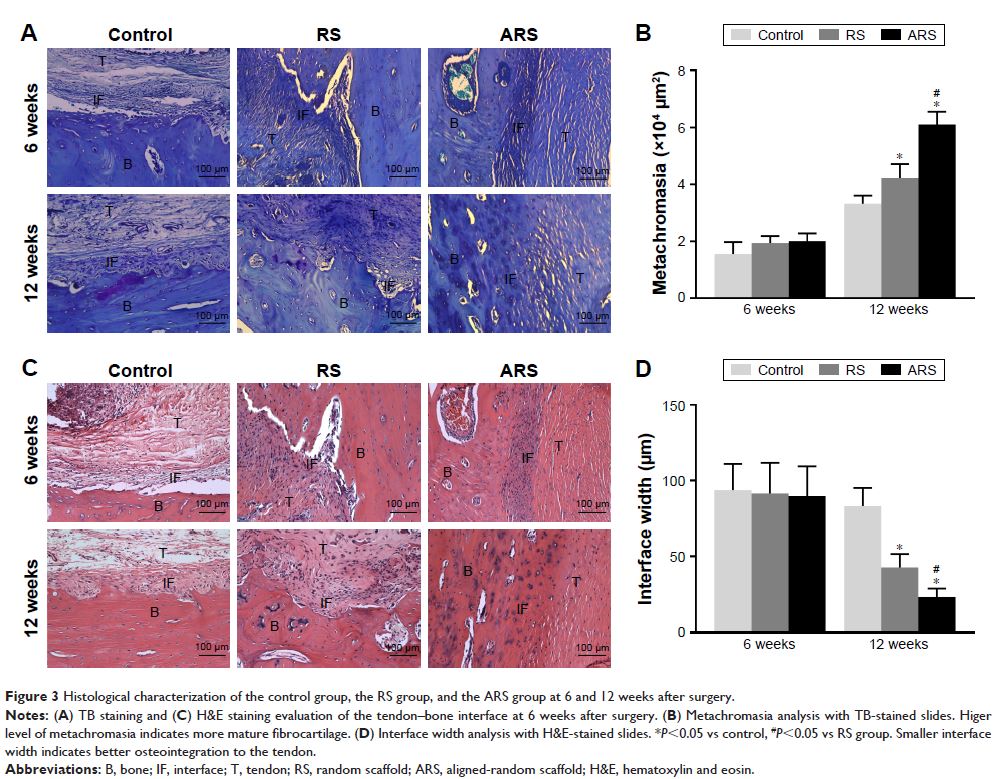108605
论文已发表
注册即可获取德孚的最新动态
IF 收录期刊
- 3.4 Breast Cancer (Dove Med Press)
- 3.2 Clin Epidemiol
- 2.6 Cancer Manag Res
- 2.9 Infect Drug Resist
- 3.7 Clin Interv Aging
- 5.1 Drug Des Dev Ther
- 3.1 Int J Chronic Obstr
- 6.6 Int J Nanomed
- 2.6 Int J Women's Health
- 2.9 Neuropsych Dis Treat
- 2.8 OncoTargets Ther
- 2.0 Patient Prefer Adher
- 2.2 Ther Clin Risk Manag
- 2.5 J Pain Res
- 3.0 Diabet Metab Synd Ob
- 3.2 Psychol Res Behav Ma
- 3.4 Nat Sci Sleep
- 1.8 Pharmgenomics Pers Med
- 2.0 Risk Manag Healthc Policy
- 4.1 J Inflamm Res
- 2.0 Int J Gen Med
- 3.4 J Hepatocell Carcinoma
- 3.0 J Asthma Allergy
- 2.2 Clin Cosmet Investig Dermatol
- 2.4 J Multidiscip Healthc

双层对齐随机纳米纤维支架用于改善兔关节外模型中肌腱与骨愈合的梯度微观结构
Authors Cai J, Wang J, Ye K, Li D, Ai C, Sheng D, Jin W, Liu X, Zhi Y, Jiang J, Chen J, Mo X, Chen S
Received 15 February 2018
Accepted for publication 26 April 2018
Published 18 June 2018 Volume 2018:13 Pages 3481—3492
DOI https://doi.org/10.2147/IJN.S165633
Checked for plagiarism Yes
Review by Single-blind
Peer reviewers approved by Dr Alexander Kharlamov
Peer reviewer comments 2
Editor who approved publication: Dr Lei Yang
Background: Tendon/ligament injuries are common sports injuries. Clinically,
the repair of a ruptured tendon or ligament to its bony insertion is needed,
but the enthesis structure is not well reestablished following surgical repair.
Herein, we fabricated dual-layer aligned-random scaffold (ARS) by
electrospinning and aimed to investigate the effect of the scaffold on
tendon-to-bone healing in vivo.
Materials and
methods: The random and dual-layer aligned-random
silk fbroin poly(L-lactic acid-co-e-caprolactone) (P(LLA-CL)) nanofibrous
scaffolds were successfully fabricated by electrospinning methods. Ninety New
Zealand white rabbits were randomly divided into three groups (random scaffold
[RS], ARS, and control groups), and they were subjected to surgery to establish
an extra-articular tendon-to-bone healing model with autologous Achilles
tendon.
Results: Histological assessment showed that the ARS significantly
increased the area of metachromasia, decreased the interface width, and
improved collagen maturation and organization at the tendon–bone interface
compared with the RS and control groups. Microcomputed tomography analysis
showed that the bone tunnel area of RS and ARS groups was significantly smaller
than those of the control group. Real-time polymerase chain reaction showed
that BMP-2 and osteopontin expression levels of the tissue at the interface
between the bone and graft in the RS and ARS groups were higher than those of
the control group at 6 weeks. Collagen I expression level of the ARS group was
significantly higher than those of the RS and control groups at 6 and 12 weeks.
Moreover, the ARS groups had a better ultimate load-to-failure and stiffness
than the RS and control groups.
Conclusion: ARS could effectively augment the tendon-to-bone integration and
improve gradient microstructure in a rabbit extra-articular model by inducing
the new bone formation, increasing the area of fibrocartilage, and improving
collagen organization and maturation. The dual-layer aligned-random silk
fibroin/P(LLA-CL) nanofibrous scaffold is proved to be a promising biomaterial
for tendon-to-bone healing.
Keywords: tendon-to-bone healing, electrospinning, aligned, random,
dual-layer
